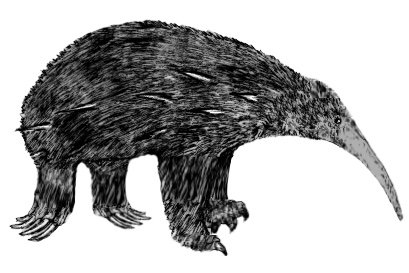Fossil Echidnas Family Tachyglossidae
Taxonomy of echidnas
Echidnas are classified into three genera, Zaglossus, Tachyglossus and Megalibgwilia. The genus Zaglossus includes three extant species that are found in New Guinea and two fossil extinct species. Tachyglossus is only known from one extant that is found in living in Australia and New Guinea. The third genus, Megalibgwilia, is known only from fossils.
Biology of fossil echidnas
Several long-beaked echidnas (Zaglossus robusta, Zaglossus hacketti, Megalibgwilia ramsayi) were part of the large-bodied (13 kg or more) fauna of Pleistocene Australia. These large echidnas are thought to have become extinct on the Australian mainland more than 10,000 years ago, so only the small T. aculeatus (mean body weight of 3.7 kg) survived. However, there has been a report that long-beaked echidnas may have survived in the Kimberley region of north-west Australia until at least the early 20th century, perhaps even today (Helgen et al., 2012).
Zaglossus
The three living Zaglossus species are endemic to New Guinea. They are rare and are hunted for food. They forage in leaf litter on the forest floor, eating earthworms and insects. The species are
Western long-beaked echidna (Z. bruijni), that live in the highland forests;
Sir David's long-beaked echidna (Z. attenboroughi), discovered by Western science in 1961 (described in 1998) and preferring a still higher habitat;
Eastern long-beaked echidna (Z. bartoni), of which four distinct subspecies have been identified.
The two fossil species are
Tachyglossus
In Australia and New Guinea, there is only one extant species for Tachyglosssus, the short-beaked echidna (Tachyglossus aculeatus).
The short-beaked echidna is found in southern, southeast and northeast New Guinea, and also occurs in almost all Australian environments, from the snow-clad Australian Alps to the deep deserts of the Outback, essentially anywhere ants and termites are available. It is smaller than the Zaglossus species, and it has longer hair.
Despite the similar dietary habits and methods of consumption to those of an anteater, there is no evidence supporting the idea that echidna-like monotremes have been myrmecophagic (ant or termite-eating) since the Cretaceous. The fossil evidence of invertebrate-feeding bandicoots and rat-kangaroos, from around the time of the platypus–echidna divergence and pre-dating Tachyglossus, show evidence that echidnas expanded into new ecospace despite competition from marsupials.[34]
Megalibgwilia
The genus Megalibgwilia is known only from fossils:
M. ramsayi from Late Pleistocene sites in Australia;
M. robusta from Miocene sites in Australia


